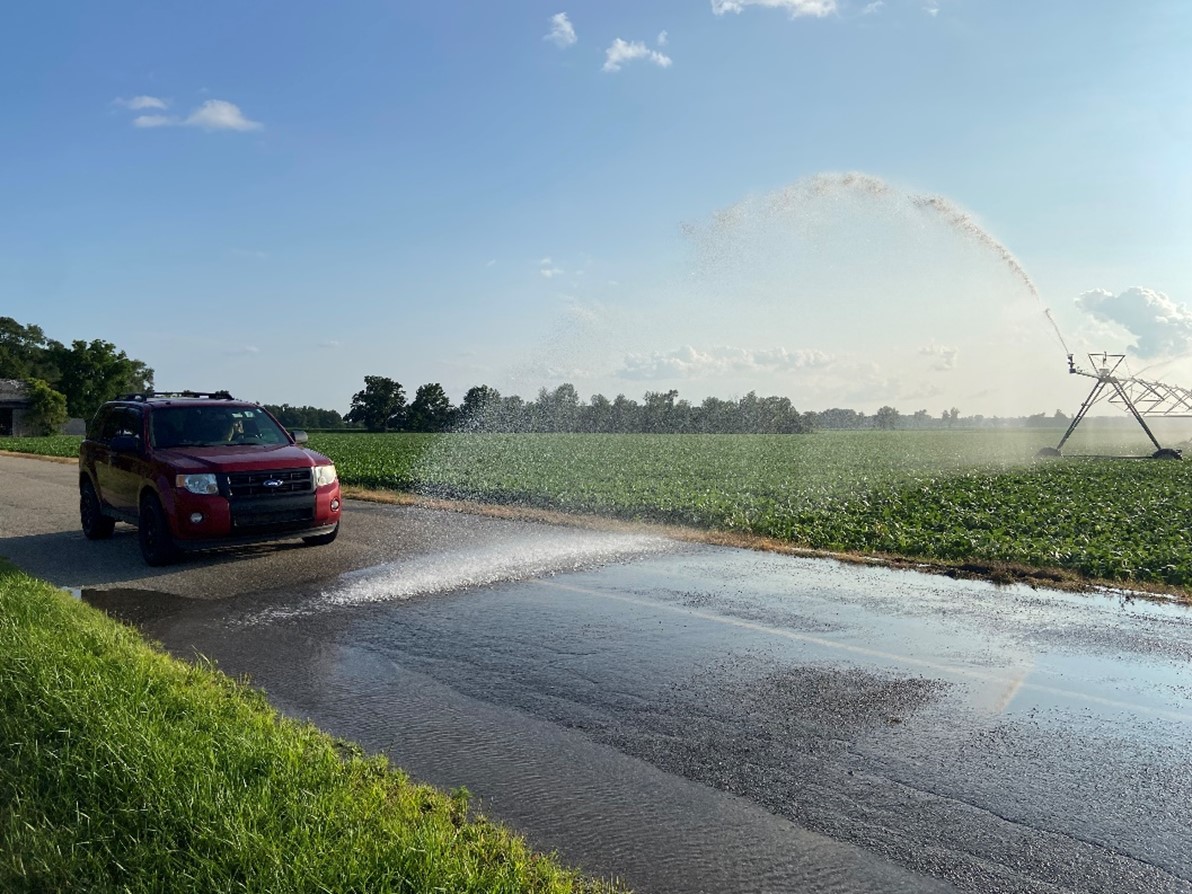Risk of irrigation water on the road
The risk associated with irrigation water on the road depends on the pressure and volume of water hitting the road and amount of traffic encountering it.

The risk of irrigation water on the road takes several forms. The major concern is the injury or loss of human life due to losing control of a vehicle when encountering the splash of water or hydroplaning on pools of water on the road. Over the past decade, several of these accidents have happened with irrigation water as a contributing factor in both Michigan and Indiana.
Other risks are the potential loss of liability insurance coverage for the farm and potential lawsuits by victims in situations where irrigation contributed to accidents. The best source of information on your farm’s insurance coverage in case of water on the road liability is the agent that services your policy.
Another often overlooked risk is the loss of good faith in the agriculture community. Many neighbors view watering the road as a disregard for the general safety of the community and a waste of water resources. Even though the total volume of water that hits the road in any situation compared to what is applied to the field is minute, water on the road issues come up often in the greater discussion of water registration and limitations. For many people, farmers who spray the road are an indication that producers just do not value the water resource.
A factor on both the liability and your community's view of irrigation may depend on the frequency that water on the road issues occur. A single event for a few minutes while you're making repairs often go unnoticed or forgotten, but chronic watering at the road becomes coffee shop talk and quickly it's assumed that all irrigators do it.

Irrigation water on the road issues also have the risk of stimulating legislation to make it a punishable offense. As of 2023, there is no specific state law that regulates irrigation water on the road in either Indiana or Michigan. Both states have wordage in their water conservation practice documents signed by large or significant-sized water users as part of their registration and water use reporting requirement, condemning off-target applications. Adding fertilizer or pesticides to irrigation water (chemigation) makes the application a punishable offense under either Michigan or Indiana’s fertilizer and pesticide requirements.
Michigan's Generally Accepted Agricultural and Management Practices for Irrigation Water Use document contains the following statement: “Operate sprinkler systems to minimize drift and off-target application. Systems should be both designed and managed to avoid off-target application of water. Observe the system at start up to minimize drift or direct spraying of water over roads, adjacent property, or structures due to system placement or high winds. Observe end guns at start up to ensure they are operating as designed to avoid over- or under-application of water.” Violation of the statement can result in a farm losing the nuisance liability protection granted by the state through the Michigan Right to Farm Act (Act 93 of 1981, as amended).
The most common offending piece of equipment is the center pivot irrigation end gun. With 100 to 150 gallons per minute at 80 to 120 pounds pressure, it drops a fair amount of water very fast. End guns are controlled by an electric switch at the center point which may be actuated by mechanical means or preprogrammed electronic system. Many electronic control systems use GPS to control the center pivot. The combination of GPS and electronic controls are more precise than mechanical controls and allows the operator to monitor the status of the end gun control valve.
Less common and of less concern is water from sprinklers that hit the road. Sprinklers are mounted on or below the main line pipe and often throw water 30 to 40 feet. Sprinkler impact on vehicles on the road is much less than the end guns because typically only the last few sprinklers are near the road. This typically happens when the system is positioned perpendicular to the road, limiting the wetted area of the road to only a small portion of the circle. Some center pivot systems are configured to run only a half circle and will start their run on the edge of the field with only small portions of each sprinkler’s wetted area hitting the road.
Big gun (also known as traveler) irrigation is a small percentage of the land base irrigated, but the potential risk of watering the road still exists. Big guns will often operate at 400 to 550 gallons per minute, dropping a lot of water very quickly. Big guns are often associated with travelers and are less automated than center pivots, relying on proper setup by the producer for each use to avoid off-target applications. Some roadside applications by stationary big guns are done to fill in dry corners missed by the center pivot. These installations are more permanent and less likely to be a common hazard to the road.
Mist from irrigation water applications may cause unexpected wet roadways but less potential risk to vehicles than direct water from the irrigation system. Wind is the major driver of mist from irrigation and can be hard to predict when it will happen.



 Print
Print Email
Email